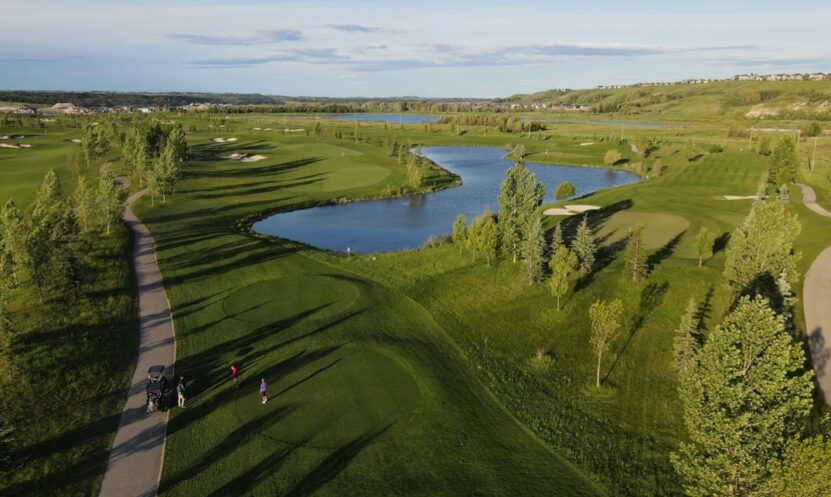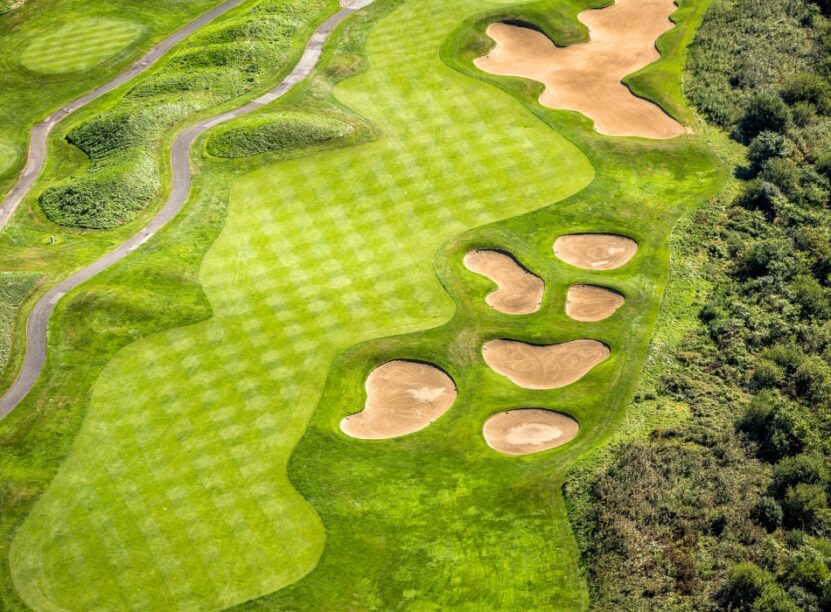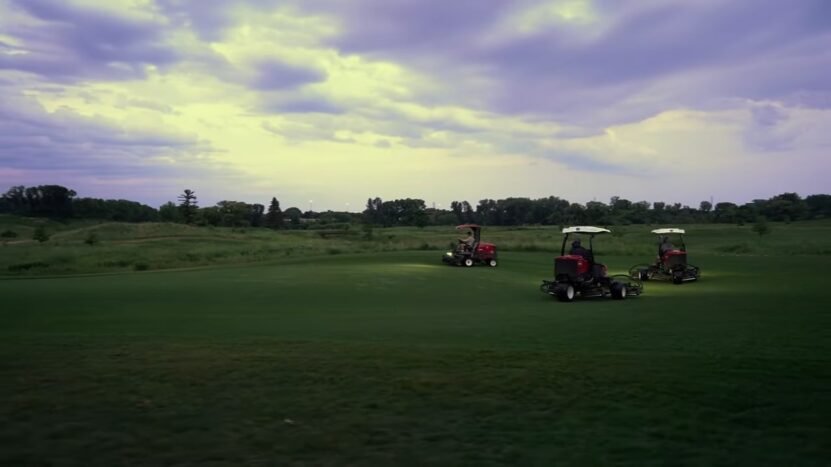Golf courses are one of the most popular leisure activities in the United States, second only to fishing. Every year, there are over 25 million golfers in the US alone, playing on around 15,500 golf courses. Each of them is unique in terms of its individual layout and design. But how many acres do they really take up?
In this guide, we will break down exactly how much acreage a single golf course requires, as well as discuss some of the other components and features that go into building a successful professional or public golf course. We will look at how land is allocated for a typical 18-hole championship course, along with other calculative factors when opening up a new green.
How Much Land Does a Golf Course Take Up?

They have long been seen as occupying vast amounts of land, but how much land does a golf course actually take up? It varies, but on average, they are rather sizable in terms of land area.
The Average Size of a Golf Course
The size depends on many factors. Depending on terrain, climate, and land availability, golf courses can range in size from small nine-hole courses to large, expansive 36-hole courses. On average, a golf course will typically measure around 6,400 yards long with the par set at 71 for an 18-hole course. This typically equates to anywhere from 100–175 acres in land area.
Most standard golf holes will typically measure 446 yards or more in length from the longest teeing resolute back to the green. Though driving distances are typically only about 200 yards for most professional players, hole yardage can increase substantially when the tees are moved further back or if hazards like water come into play.
While most par fours measure between 445 and 505 yards and most par fives between 535–615 yards (on average), some of the world’s longest holes managed by The Professional Golfers’ Association (PGA) can reach ridiculous lengths of 800+ yards! The enormous distance these monster holes require also requires more land — which is why some world-class courses measure upwards of around 200 acres per 18 holes!

Variations in Size and Layout
While it is almost impossible to come up with an exact answer, there are certain averages that professionals in the golfing industry typically use. On average, they will require no less than 110 acres of land—and this may include the surrounding areas, such as driving ranges and parking lots. However, it can become significantly higher than this depending on size and layout variations from one course to the next.
For instance, a minimalist design may require no more than 75-90 acres of land and the length of a hole can range from 80 to 250 yards depending on the terrain–factors that all play a role in determining how much land a single golf course requires. A 9-hole course can take up anywhere from 45 to 90 acres while an 18-hole will likely require double the amount of space due to more playable terrain and more elaborate bunkers and obstacles. Some courses may even have more holes or additional facilities (such as driving ranges) which will add even more acreage to the overall requirement.
Similarly, different elevations along with sand dunes may also contribute to an increase in necessary land since these surfaces create significant drainage problems if not accounted for properly when establishing a golf course layout. Couple this with varying water elements for ponds or streams, as well as other cultural features like trees planted for aesthetics, and you could see why certain courses may need tens or hundreds of extra acres beyond what is usually required for your standard tournament rounds.
Components of a Golf Course

They can be found in many different shapes and sizes around the world. However, there are some common components of each golf course no matter where it is located. These components include the tee box, the fairway, and the green.
In addition, they are typically made of up large areas of land, so it is important to understand how many acres golf courses really take up.
Let’s explore their different components and the amount of acreage they occupy.
Fairways
Fairways, the primary playing surfaces of a golf course, are the most extensively maintained and manipulated components of a course. In combination with the other elements of the course, they provide a tremendous challenge to players of all abilities by routing them through the design while simultaneously requiring precision and accuracy in order to score successfully.
They generally consist of mowed grasses that have been cut to different heights allowing for varying degrees of playability and ball control. The amount and type of grass varieties as well as their respective maintenance practices are determined by conditions such as traffic and area availability. Fairways usually represent over 50% of a golf course’s acreage but can run up to 70% depending on circumstances surrounding each particular design.
The condition and quality of the fairway turf are key to providing enjoyable rounds for players at all levels, but especially low handicappers who often require more consistent surfaces in order to accurately gauge their golf shots from tee to green. Fairways must also be carefully thought out in terms of design so that they connect naturally with tee boxes, affect green complexes, or bring water hazards or bunkers into play along with other strategic elements.
To ensure playable conditions throughout an entire round, fairways must be managed heavily so as to best suit each particular site; this includes frequent mowing, rolling/tining in dry light forms when possible, or even wetting for softer conditions when necessary.
Greens

Greens are the most important and heavily maintained areas of a golf course. They typically cover about 15 percent of the total course area and present a significant challenge on every hole. Most golfers immediately think of improving putting techniques when faced with challenging greens, but skilled designers take not only putting contours into account but also maintaining slopes to achieve perfect drainage in case of heavy rainfall.
Generally speaking, greens fall into two categories – so-called capped and bent greens. Capped greens contain a top layer of turfgrass that sits on top of native soil while bent greens have a thin layer of sand called “cap” installed between the soil and turfgrass which helps reduce drought stress as well as improve ball roll quality and green speed (the speed at which an ideally-made true putt rolls over the surface).
Good greenkeeping practices to maintain healthy playing conditions require adequate water inputs along with regular checking for disease presence and promoting healthy growth through fertilization efforts. Regular aerifying will also ensure better oxygen levels in the soil. On average, an 18-hole golf course has about 34 acres dedicated to green surfaces – representing about one-fifth of the total acreage.
Tees
When an individual plays a game of golf, his or her ball needs to be placed on the tee box at the beginning of each hole. Tees, which are constructed with gravel, stone, and/or artificial turf, are raised square boxes that measure between 4-5 inches on each side. The main component of the tee box is evenly balanced tees that come in different heights and can be adjusted due to the type of club being used for any given shot.

Tee boxes often have topographical mounds to support good visibility for all golfers. While most tee boxes are generally flat and feature standard designs, some courses might include unique forms like ovals or circles. Additionally, tees may be constructed with prefabricated mounds that feature fairway bunker grasses so they blend into the course’s overall landscape design. Of course, multiple types of grass can also be blended together in order to create interesting designs that provide beauty as well as challenging shots from elevated areas or distance points.
Sand Traps
Sand traps, also known as bunkers, are sandy areas placed around the golf course for strategic purposes. They are shallow depressions that are filled with sand and are specially designed to stop or slow down the ball when it is struck off-line from the green or other areas of play.
The size and shape of these features can be varied throughout a link to give players a challenge by forcing them to hit shots over them or around them. A typical sand trap might measure 40 feet long by 20 feet wide and depth may vary from 8 inches (the minimum) up to 3 feet deep at its deepest part, depending on the design of the course and its bunkers.
The kind of sand used in these features should be carefully chosen so that it has firm support but still provides a reasonable amount of movement when played from. Depending on location, beach sand may work perfectly while other courses might require more specialized mixes depending on local resources.
Optimal bunker setup will usually be established before play begins so that they don’t become a hazard after several rounds when movement is needed to restore presentation qualities each week. Additionally, well-maintained traps offer a desirable visual element that enhances every course’s overall aesthetic appeal.
Landscaping and Maintenance

They are not just about the game, they are about the environment and the landscape. Every golf course requires a good mix of landscaping and maintenance to ensure top-notch golf course conditions.
This section will focus on the amount of land needed for this type of landscape design and maintenance. We will analyze the different aspects of landscaping and maintenance and determine how many acres they require.
Maintaining the Course’s Landscaping
They take up a significant amount of land that must be maintained and kept looking beautiful in order to provide a pleasant experience for all golfers. Depending on the size of the course, this may require a large team of landscapers who are responsible for trimming, mowing, and caring for all aspects of the property’s natural environment.
This includes pruning trees, shrubs, and grasses to maintain proper length and height; removing weeds and dead foliage; selecting and planting new grasses; setting up irrigation systems; sowing wildflower seed; constructing ponds and lakes; stretching nets to capture errant golf balls; placing flower beds at vantage points throughout the course, etc.
In addition to maintaining existing landscaping elements, a good landscaper will also look for ways to improve the course’s natural surroundings. This can include planting native plants that will attract wildlife such as bees or butterflies or creating designated areas where course players can observe waterfowl during their round. The ongoing nature of this work requires attention from these skilled professionals in order to keep the golfers coming back for more.
Water Management
Water management is an essential factor in golf course landscaping and maintenance. Adequate watering allows them to remain in a presentable condition, as well as to provide a more stable playing experience for golfers. In order to maintain consistent water levels on the course, irrigation systems are equipped with rain gauges, soil sensors and pressure-based control units to help minimize waste. Utilizing these systems, 90% of the water used by them is recycled or repurposed, making questionable water usage allegations largely unfounded.
In addition to implementing automated irrigation technologies and practicing frequent maintenance checks on pumps, sprinkler heads, and turf areas, there are several techniques that can be employed to help conserve water used on it.
This includes creating buffer zones around ponds and lakes in order to control runoff from adjacent lawns; utilizing well-draining soils like growing media mixes for sand traps; reducing the turfgrass areas; utilizing droplet dispersion for more distant grasses; making use of automatic water shut-off devices when surrounding routes become wet enough; proper fertilization which reduces the need for overwatering; using mulch in flower beds that retains moisture longer before needing replenishing; and constructing berms with dry creek beds whenever possible in order build swales which will slow ground runoff and prevent soil erosion while collecting any incoming waters into it until they evaporate or disperse into other areas of vegetation.
By leveraging these cost-effective conservation strategies along with assiduous landscape maintenance protocols such as timely mowing practices, aerating soil profiles throughout play season months, and cultivating healthy topsoil layers with biological additives such as microbial cakes or their organic counterparts – fish meal fertilizer – greenkeepers can help keep overly wasteful golfing habits in check while providing an acceptable level of playing conditions for their patrons.
FAQs

What percentage of a golf course is actually grass?
Approximately 70% of it is grass, including the fairways, greens, and roughs.
How many acres are typically devoted to fairways on a golf course?
The number of acres devoted to fairways varies, but an average 18-hole golf course typically allocates around 60 acres of land for fairways.
How much space is used for sand traps?
On average, about 3 to 5 acres of land are used for sand traps on it.
How much land is dedicated to water features on a golf course?
The amount of land dedicated to water features varies from one to another but typically ranges from 5 to 10 acres.
What is the size of a standard golf green?
A standard golf green is usually around 5,000 to 7,000 square feet in size.
How much land does a driving range require?
A driving range typically requires between 7 and 10 acres of land.
How much land is needed for a mini-golf course?
It can range from 1 to 3 acres, depending on the number of holes and the complexity of it.
Can a smaller golf course still be challenging?
Yes, even smaller ones can be challenging if the design incorporates unique features and strategic shot placements.
How does the size of a golf course affect maintenance costs?
Larger ones typically require more maintenance, which translates to higher costs for upkeep, equipment, and labor.
How do golf courses contribute to the environment?
They can contribute positively to the environment by preserving green spaces, providing habitats for wildlife, and implementing sustainable practices like water conservation and pesticide reduction.
Conclusion
In conclusion, they can take up a significant amount of space, ranging from tens of acres to hundreds. The size of the course largely depends on the type of course and where it is located. Often times they are found near more rural areas, as they require such a large amount of land.
Additionally, a number of other factors also determine the size and complexity of golf courses such as terrain, weather conditions, club priority and regulations.
While they are usually associated with large amounts of land usage in their construction, facility operators are now seeking to reduce this number with more eco-friendly practices in order to conserve resources and decrease their footprint on the environment.

